Presenters flex their muscles during Anatomy of Sports program
By: Paul Bello, National Museum of Health and Medicine
SILVER SPRING, Md. – Anatomy of Sports – a medical illustration program in its third year at the National Museum of Health and Medicine (NMHM) – was held Aug. 9 at the museum on the Fort Detrick-Forest Glen Annex in Silver Spring, Md. The program pairs athletes with medical illustrators and physical therapists from around the region to demonstrate how muscles and bones in the human body work together.
Marie Dauenheimer, a medical illustrator from Reston, Va., returned for a second year to take part in the program. She was stationed at the Tae Kwon Do tent along with Donte Branch, a 3rd degree black belt from Silver Spring.
"I believe it's a wonderful way for people, particularly young kids, to learn about the elements of the human body," Dauenheimer said. "Sports are an exciting attraction for people. This kind of presentation is fun and educational at the same time."
Sitting atop his mountain bike at the cycling tent was Glenn Thomas, a retired Air Force meteorologist and current physical therapist in the metropolitan area. While medical illustrator Judith Stoffer, of the Walter Reed Army Institute of Research, painted the muscles of Thomas' lower leg, the cyclist joked with some nearby children that his muscles were now just as big as theirs. He also said a program like Anatomy of Sports was a great way for people to start a conversation about the importance of physical fitness.
"There's a lot to the human body that people don't know about," Thomas said. "If people understand how the body works, that will only help them stay in better shape and prevent injuries."
U.S. Marine Corps Maj. Eric Marshall was the featured athlete at this year's ultra-running tent. Medical illustrator Elizabeth Weissbrod, of the Val G. Hemming Simulation Center of the Uniformed Services University, focused on the bones and muscles of Marshall's lower leg and foot. According to Marshall, he keeps himself in peak shape by running five miles a day anywhere from three or four times a week.
"It's important to enjoy working out and staying fit. Gearing yourself up mentally is key," Marshall said. "The best advice I could offer someone is to start off slow and gradually build up their stamina. Good things come in time."
Marshall's workout regimen also includes swimming, another sport featured during Anatomy of Sports. Illustrator Ikumi Kayama painted the back muscles of Gwen Nelmes, NMHM tour program coordinator. Nelmes, a competitive swimmer for more than 15 years, recently returned to the sport after a shoulder injury.
A fifth tent was dedicated to football. That's where science illustrator Taina Litwak could be found painting Calvin Baxter, a former high school football player and current physical therapist.
"This is a wonderful program the museum puts on for the community," Litwak said. "It's a great way to learn about the body. I would love to see even more people attend."
Baxter, who was participating in his first Anatomy of Sports, has been directing his own clinic in Silver Spring, Md., for the past decade. He also believes the program has an enormous educational benefit.
"I'm so happy to have participated. I think this is a wonderful way for people to learn about sports fitness," Baxter said. "I've enjoyed learning about and seeing our muscles in action. That's the biggest takeaway from all this."
In addition to this year's athletes, artists and professional therapists was a group of physical therapy students from the University of Maryland at Baltimore. They talked to each presenter about their respective profession or sport, including Carol Cantello, a physical therapist in charge of a clinic in Manassas, Va.
"We got great advice from everyone that was here. We also learned about the different options available to us in terms of a physical therapy career and what career path to follow," said Madison Burke, a second year student at the school. "We're excited to go back to school and share what we learned today with our classmates."
Andrea Schierkolk, NMHM public program manager, said the museum has a 150-year history of incorporating medical illustration into the interpretation of anatomy, trauma and pathology. She believes the Anatomy of Sports program provides a contemporary opportunity to blend art with science.
First established in 1862 as the Army Medical Museum, NMHM is a Department of Defense museum that inspires interest in and promotes the understanding of medicine – past, present and future – with a special emphasis on tri-service American military medicine. It has been recognized as a national historic landmark for its ongoing value to the health of the military and to the nation.
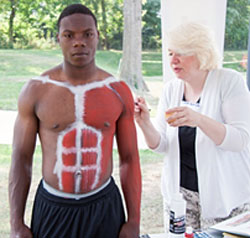 |
Caption: Donte Branch, a 3rd-degree black belt, participates along with Marie Dauenheimer, a medical illustrator, at the Anatomy of Sports program held on August 9, 2014 at the National Museum of Health and Medicine (NMHM) in Silver Spring, Md. The Anatomy of Sports program was created to highlight the importance of science, technology, engineering, art and math (STEAM)-related concepts to the public from around the region. |
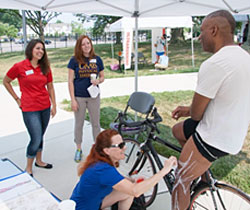 |
Caption: Glenn Thomas, right, a local physical therapist and retired Air Force meteorologist, talks with University of Maryland students Dakotah Bosworth and Holly Hibbard during the Anatomy of Sports program held on August 9, 2014 at the National Museum of Health and Medicine (NMHM) in Silver Spring, Md. Volunteering as one of the day’s illustrators was Judith Stoffer, a medical illustrator with the Walter Reed Army Institute of Research (WRAIR). The Anatomy of Sports program was created to highlight the importance of science, technology, engineering, art and math (STEAM)-related concepts to the public from around the region. |
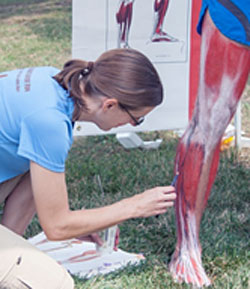 |
Caption: Elizabeth Weissbrod, a medical illustrator with the Uniformed Services University Val G. Hemming Simulation Center, highlights the muscles of the leg and foot as part of the Anatomy of Sports program held on August 9, 2014 at the National Museum of Health and Medicine (NMHM) in Silver Spring, Md. The Anatomy of Sports program was created to highlight the importance of science, technology, engineering, art and math (STEAM)-related concepts to the public from around the region. |
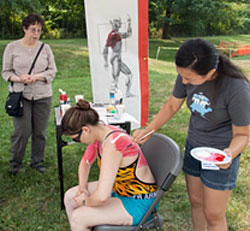 |
Caption: Ikumi Kayama, right, an illustrator in the DC area, paints the back and shoulder of Gwen Nelmes, National Museum of Health and Medicine (NMHM) tour program, during the Anatomy of Sports program held on August 9, 2014 in Silver Spring, Md. The Anatomy of Sports program was created to highlight the importance of science, technology, engineering, art and math (STEAM)-related concepts to the public from around the region. |
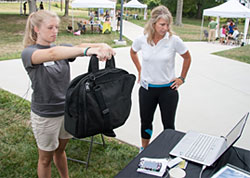 |
Caption: Andrea Hendrix, a physical therapy student at the University of Maryland, participates in an exercise observed by Carol Cantello, a licensed physical therapist from Manassas, Va. Both were participants during the Anatomy of Sports program held at the National Museum of Health and Medicine (NMHM) on August 9, 2014 in Silver Spring, Md. The Anatomy of Sports program was created to highlight the importance of science, technology, engineering, art and math (STEAM)-related concepts to the public from around the region. |
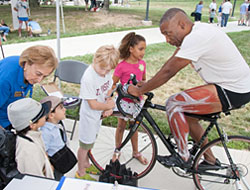 |
Caption: Glenn Thomas, right, a local physical therapist and retired Air Force meteorologist, talks with some children during Anatomy of Sports program held on August 9, 2014 at the National Museum of Health and Medicine (NMHM) in Silver Spring, Md. The Anatomy of Sports program was created to highlight the importance of science, technology, engineering, art and math (STEAM)-related concepts to the public from around the region. |
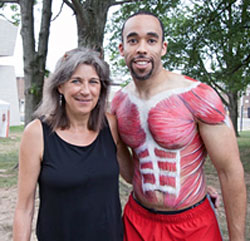 |
Caption: Science illustrator Taina Litnak poses for a photograph with Calvin Baxter, a physical therapist from Silver Spring, Md., during this year’s Anatomy of Sports program held on August 9, 2014 at the National Museum of Health and Medicine (NMHM) in Silver Spring, Md. The Anatomy of Sports program was created to highlight the importance of science, technology, engineering, art and math (STEAM)-related concepts to the public from around the region. |
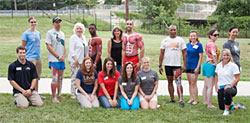 |
Caption: Athletes, artists and physical therapists come together for a group picture at the conclusion of this year’s Anatomy of Sports program held on August 9, 2014 at the National Museum of Health and Medicine (NMHM) in Silver Spring, Md. The Anatomy of Sports program was created to highlight the importance of science, technology, engineering, art and math (STEAM)-related concepts to the public from around the region. |



